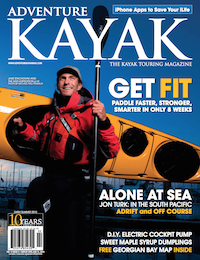The traditional image of sea kayaking is idyllic floats on mirror-calm water. Filmmaker Justine Curgenven famously began This Is The Sea, tongue in cheek, with “Ah, sea kayaking. Old men with beards, enjoying nature.” But that’s all changing.
A rough-water trend has been growing con- tinent-wide. Take the Lumpy Water Sympo- sium, a new event organized last October by Oregon’s Alder creek Kayak and canoe. Held amidst a nasty recession, with equally nasty conditions—strong winds and big choppy surf—the event sold out, with a waiting list. And it was dominated by new folks.
Nor is the trend limited to the West Coast. The Maine Island Kayak company has an intermediate-level Rough Water Symposium planned for June 2010 in Rhode Island. Ontario has the three-year-old Georgian Bay Storm Gathering as well as Naturally Superior Adventures’ Surfing Superior confluence. British Columbia’s Coast Mountains Expeditions is planning their first-ever “whitewater sea kayak” festival in Surge Narrows in June of 2011.
This isn’t the first time that sea kayaking has ventured down the rough-water path. The legendary Gales of November gathering, organized by Stan Chladek on Lake Superior’s North Shore, just celebrated its 24th anniversary. Fifteen years ago we had the Tsunami Rangers, a frenetic group of california pad- dlers wearing motocross body armour and addressing each other by naval rank. But the old-school focus on extreme sea kayaking and the resulting carnage never caught on.
So why the renewed interest in the rough stuff? Some attribute it to the popularity of video productions by the likes of Justine Curgenven and Bryan Smith, or the growth of the British canoe Union’s instructional system, influenced by its homeland of strong tidal cur- rents and exposed waters. Other factors include the growing variety of nimble, highly rockered boats increasingly available in plastic that ap- peal to budget-conscious rock-bashers. As with any trend, it’s tough to sift cause from effect.
Busy schedules may also be a factor.“People seem to have less time to take extended trips, so they compensate by packing a lot of paddling excitement into a smaller challenging, thrilling and satisfying daily package,” says David Wells of Naturally Superior Adventures.
Also, where the Tsunami Rangers and the Gales of November were invitation-only gatherings of elite professional paddlers, this new crop of events isn’t just for the top level. “The biggest reason we had success was the inclusive nature,” says Paul Kuthe, an instructor at Lumpy Waters whose talents appear in Bryan Smith’s Pacific Horizons and The Season. “We provided something for all skill levels and made sure people knew that they would be successful whatever their goals.”
Not everyone agrees that the rough-water trend is the future of sea kayaking. Dave Slover, owner of Alder Creek Kayak and canoe, notes that “of the thousands of boats we have sold over the years very few people move on to paddle in rough conditions.” But kayaking in general is growing. According to the Outdoor Industry Foundation, the number of kayakers nearly doubled from 2006 to 2008. So even if the percentage seeking aerated water remains the same, it’s on a sharp upward trend that may be approaching critical mass.
And with much of the North American coast guarded by surf, rough-water experience opens a huge door. The next question is: What does it take to nurture and sustain a strong rough-water sea kayaking community?
The obvious elements are access to condi- tions and good instruction. But there’s more. “Successful rough-water communities develop when opportunities for growth and skill build- ing are combined with beer and socializing,” says Kuthe. “Kayaking is similar to Harley motorcycle gangs in that the people that par- ticipate don’t just think of themselves as people that kayak. They are kayakers.”
So venturing into rough conditions may forge sea kayaking from recreation to passion and then to identity. Keep it up and maybe someday we’ll need leather jackets as well as drysuits.
“It always annoys me when people think of sea kayaking as boring,” Kuthe says before leaving for yet another rough-water symposium under the Golden Gate Bridge, where he’ll no doubt show people otherwise.




